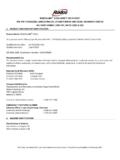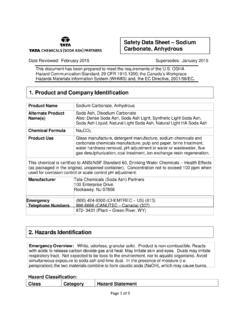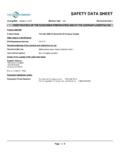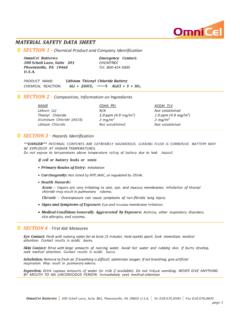Transcription of RADCOLUBE SBR-1 SAFETY DATA SHEET MIL-PRF …
1 RADCOLUBE SBR-1 SAFETY data SHEET MIL-PRF -46176B BRAKE FLUID, SILICONE, AUTOMOTIVE, ALL-WEATHER, OPERATIONAL AND PRESERVATIVE Page 1 of 7 This SAFETY data SHEET (SDS) meets the Globally Harmonized System of Classification and Labeling of Chemicals (GHS). 1. PRODUCT AND COMPANY IDENTIFICATION Product Name RADCOLUBE SBR-1 This product meets Military Specification MIL-PRF -46176B and US DOT 5 Qualification Number (Effective Date) SBF-1031 (10 November 2016) SBF-1033 (23 January 2017) ISO 9001:2008 Certification Number: C2015-00068 Recommended Use The brake fluid covered by this specification is military unique due to the requirement that it perform at a minimum ambient temperature of 55 C, whereas commercial silicone-based brake fluids are rated at a minimum ambient temperature of 40 C.
2 It is intended for use as an operational fluid and preservative fluid in automotive hydraulic brake systems at ambient temperatures ranging from 55 C to -55 C and fluid temperatures ranging from 205 C to -55 C. If brake fluid in accordance with MIL-PRF -46176B performance specification is used to replace another type of brake fluid, adequate flushing of the brake system must be accomplished to remove all traces of the brake fluid that is to be replaced. If these fluids are not completely removed, the corrosion-protective and preservative properties of the silicone fluid will be negated. National Stock Numbers (NSN): 9150-01-102-9455 Gallon 9150-01-123-3152 5 Gallon Pail 9150-01-072-8379 55 Gallon Drum Company Identification Headquarters and Manufacturing Facility (CAGE Code 6ZS16) Radco Industries, Inc.
3 700 Kingsland Drive Batavia, IL 60510 Manufacturing Facility (CAGE Code 1 RVC4) Radco Industries, Inc. 39W930 Midan Drive LaFox, IL 60147 Customer information number: 1-630-232-7966 EMERGENCY TELEPHONE NUMBER Advisory Office in case of poisoning: Chemtrec Chemtrec (North America): 1-800-424-9300 2. HAZARDS IDENTIFICATION Classification of mixture: Carcinogenicity, Category 2 Eye irritation, Category 2A Skin irritation, Category 2A Hazard Pictograms: Radco Industries, Inc. 700 Kingsland Drive, Batavia, Illinois 60510, United States Product Name: RADCOLUBE SBR-1 MIL-PRF -46176B BRAKE FLUID, SILICONE, AUTOMOTIVE, ALL-WEATHER, OPERATIONAL AND PRESERVATIVE Page 2 of 7 This SAFETY data SHEET (SDS) meets the Globally Harmonized System of Classification and Labeling of Chemicals (GHS).
4 Signal Word WARNING Hazard Statements: H303: May be harmful if swallowed. H315 + H320: Causes eye and skin irritation. H351: Suspected of causing cancer. Precautionary Statements: P202: Do not handle until all SAFETY precautions have been read and understood. P273: Avoid release to the environment. P281: Use personal protective equipment as required. P301 + P331 + P313: IF SWALLOWED: Do NOT induce vomiting. Get medical advice/attention. P305 + P351 + P338 P337 + P313: IF IN EYES: Rinse cautiously with water for several minutes. Remove contact lenses if present and easy to do continue rinsing. If eye irritation persists, get medical advice/attention.
5 P302 + P350 + P333 + P313: IF ON SKIN: Wash with soap and water. If skin irritation or a rash occurs: Get medical advice/attention. P362: Take off contaminated clothing and wash before reuse. P405: Store locked up. P501: Dispose of contents/container to an approved waste disposal plant. 3. COMPOSITION/INFORMATION ON INGREDIENTS Components %Content CAS Number Polydimethylsiloxane Balance 63148-62-9 Tributyl Phosphate < 10% 126-73-8 Bis(2-ethylhexyl) sebecate < 10% 122-62-3 4. FIRST-AID MEASURES Eyes Prevent this fluid from coming in contact with the eyes as it may cause irritation. Wash the hands thoroughly after exposure.
6 Upon accidental eye exposure, wash the eyes promptly with water for at least fifteen (15) minutes. Eye hazard is neither severe nor permanent. Ingestion If swallowed, do NOT induce vomiting. Get medical attention immediately. Inhalation Move to fresh air. If unconscious place in recovery position and seek medical advice. If respiratory irritation, dizziness, nausea, or unconsciousness occurs, seek immediate medical assistance. Remove from further exposure. Immediately call a doctor. Skin Wash skin thoroughly with mild soap and plenty of water for at least 15 minutes. 5. FIRE-FIGHTING MEASURES Suitable Extinguishing Media For small fires use carbon dioxide, dry chemical or foam.
7 For large fires use alcohol-type foam, universal type foam or water fog. Fire-Fighting Equipment Firefighter should wear normal protective equipment (full bunker gear) and positive-pressure contained breathing apparatus. Water can be used to cool fire-exposed containers, to protect personnel and to disperse vapors and spills. Water runoff can cause environmental damage. Dike and collect water used to fight fires. Special Fire-Fighting Procedures Use water spray to cool fire-exposed containers and structures. If a rail or tank truck is involved in a fire, isolate for 800 meters ( mile) in all directions. Shut off fuel to fire if it is possible to do so without hazard.
8 If this is impossible, withdraw from the area and let the fire burn out under controlled conditions. Withdraw immediately in case of rising sound from venting SAFETY device or any discoloration of tank due to fire. Radco Industries, Inc. 700 Kingsland Drive, Batavia, Illinois 60510, United States Product Name: RADCOLUBE SBR-1 MIL-PRF -46176B BRAKE FLUID, SILICONE, AUTOMOTIVE, ALL-WEATHER, OPERATIONAL AND PRESERVATIVE Page 3 of 7 This SAFETY data SHEET (SDS) meets the Globally Harmonized System of Classification and Labeling of Chemicals (GHS). 6. ACCIDENTAL RELEASE MEASURES Wear protective clothing when taking up spill.
9 Eliminate sources of ignition. This product is insoluble in water and will float on the surface. Prevent from entering sewers or drains. Should this product enter sewers or drains, it should be pumped out into an open vessel. 7. HANDLING AND STORAGE Handling Do not breathe vapors/dust. Smoking, eating and drinking should be prohibited in the application area. Dispose of rinse water in accordance with local and national regulations. Storage Do not store in open or unlabeled containers. Keep container tightly closed in a dry and well-ventilated place. 8. EXPOSURE CONTROLS/PERSONAL PROTECTION Component CAS Number EC Number Permissible Exposure Limits (PEL) Bis(2-ethylhexyl) sebacate 122-62-3 204-558-8 None established Polydimethylsiloxane 63148-62-9 613-156-5 None established Tributyl phosphate 126-73-8 204-800-2 ACGIH Threshold Limit Values (TLV): NIOSH Recommended Exposure Limits: Occupational Exposure Limits (OSHA) - Table Z-1: PEL California permissible exposure limits (Title 8, Article 107): 5 mg/m3; ppm mg/m3; ppm 5 mg/m3 mg/m3; ppm Respiratory Protection Use with adequate ventilation.
10 Avoid breathing vapor. If heated and ventilation is inadequate, use NIOSH certified respirator, which will protect against organic vapor. Hand Protection Wear clothing and gloves that cannot be penetrated by chemicals or oil. Eye Protection SAFETY glasses, chemical goggles, or face shields recommended to prevent contact. Other Protection Do not eat, drink, or smoke when handling this product. 9. PHYSICAL AND CHEMICAL PROPERTIES Appearance: Violet viscous fluid Odor: Odorless Odor threshold: Not determined Auto-ignition temperature: Not determined Decomposition temperature: Not determined Evaporation Rate (ASTM D972): Not determined Flash point Cleveland Open Cup (ASTM D92): 204 C (399 F) Flash point Pensky-Martens (ASTM D93): Not determined Flammability (solid, gas): Non-flammable Lower flammability limit: Not determined Upper flammability limit: Not determined Initial boiling point and boiling range: Not determined Melting point/freezing point.









